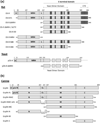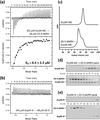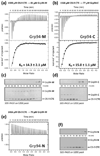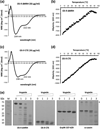Characterization of the Grp94/OS-9 chaperone-lectin complex
- PMID: 25193139
- PMCID: PMC4188734
- DOI: 10.1016/j.jmb.2014.08.024
Characterization of the Grp94/OS-9 chaperone-lectin complex
Abstract
Grp94 is a macromolecular chaperone belonging to the hsp90 family and is the most abundant glycoprotein in the endoplasmic reticulum (ER) of mammals. In addition to its essential role in protein folding, Grp94 was proposed to participate in the ER-associated degradation quality control pathway by interacting with the lectin OS-9, a sensor for terminally misfolded proteins. To understand how OS-9 interacts with ER chaperone proteins, we mapped its interaction with Grp94. Glycosylation of the full-length Grp94 protein was essential for OS-9 binding, although deletion of the Grp94 N-terminal domain relieved this requirement suggesting that the effect was allosteric rather than direct. Although yeast OS-9 is composed of a well-established N-terminal mannose recognition homology lectin domain and a C-terminal dimerization domain, we find that the C-terminal domain of OS-9 in higher eukaryotes contains "mammalian-specific insets" that are specifically recognized by the middle and C-terminal domains of Grp94. Additionally, the Grp94 binding domain in OS-9 was found to be intrinsically disordered. The biochemical analysis of the interacting regions provides insight into the manner by which the two associate and it additionally hints at a plausible biological role for the Grp94/OS-9 complex.
Keywords: ER-associated degradation; Grp94; Hsp90; chaperone; intrinsically disordered protein.
Copyright © 2014 Elsevier Ltd. All rights reserved.
Figures







Similar articles
-
OS-9 facilitates turnover of nonnative GRP94 marked by hyperglycosylation.Mol Biol Cell. 2014 Aug 1;25(15):2220-34. doi: 10.1091/mbc.E14-03-0805. Epub 2014 Jun 4. Mol Biol Cell. 2014. PMID: 24899641 Free PMC article.
-
Human OS-9, a lectin required for glycoprotein endoplasmic reticulum-associated degradation, recognizes mannose-trimmed N-glycans.J Biol Chem. 2009 Jun 19;284(25):17061-17068. doi: 10.1074/jbc.M809725200. Epub 2009 Apr 3. J Biol Chem. 2009. PMID: 19346256 Free PMC article.
-
The endoplasmic reticulum-associated protein, OS-9, behaves as a lectin in targeting the immature calcium-sensing receptor.J Cell Physiol. 2018 Jan;233(1):38-56. doi: 10.1002/jcp.25957. Epub 2017 Jun 5. J Cell Physiol. 2018. PMID: 28419469
-
Mannose 6-phosphate receptor homology domain-containing lectins in mammalian endoplasmic reticulum-associated degradation.Methods Enzymol. 2010;480:181-97. doi: 10.1016/S0076-6879(10)80010-2. Methods Enzymol. 2010. PMID: 20816211 Review.
-
Protein quality control in the ER: the recognition of misfolded proteins.Semin Cell Dev Biol. 2010 Jul;21(5):500-11. doi: 10.1016/j.semcdb.2010.03.006. Epub 2010 Mar 25. Semin Cell Dev Biol. 2010. PMID: 20347046 Review.
Cited by
-
Glucose-regulated protein 94 is a novel glioma biomarker and promotes the aggressiveness of glioma via Wnt/β-catenin signaling pathway.Tumour Biol. 2015 Dec;36(12):9357-64. doi: 10.1007/s13277-015-3635-4. Epub 2015 Jun 25. Tumour Biol. 2015. PMID: 26108996
-
The Hsp90 ensemble: coordinated Hsp90-cochaperone complexes regulate diverse cellular processes.Nat Struct Mol Biol. 2014 Dec;21(12):1017-21. doi: 10.1038/nsmb.2927. Nat Struct Mol Biol. 2014. PMID: 25469839 No abstract available.
-
The Essential Functions of Molecular Chaperones and Folding Enzymes in Maintaining Endoplasmic Reticulum Homeostasis.J Mol Biol. 2024 Jul 15;436(14):168418. doi: 10.1016/j.jmb.2023.168418. Epub 2023 Dec 22. J Mol Biol. 2024. PMID: 38143019 Free PMC article. Review.
-
Heterologous expression of influenza haemagglutinin leads to early and transient activation of the unfolded protein response in Nicotiana benthamiana.Plant Biotechnol J. 2024 May;22(5):1146-1163. doi: 10.1111/pbi.14252. Epub 2023 Dec 1. Plant Biotechnol J. 2024. PMID: 38038125 Free PMC article.
-
Emerging structural insights into glycoprotein quality control coupled with N-glycan processing in the endoplasmic reticulum.Molecules. 2015 Jan 30;20(2):2475-91. doi: 10.3390/molecules20022475. Molecules. 2015. PMID: 25647580 Free PMC article. Review.
References
-
- Argon Y, Simen BB. GRP94, an ER chaperone with protein and peptide binding properties. Seminars in Cell & Developmental Biology. 1999;10:495–505. - PubMed
-
- Koch G, Smith M, Macer D, Webster P, Mortara R. Endoplasmic reticulum contains a common, abundant calcium-binding glycoprotein, endoplasmin. J Cell Sci. 1986;86:217–232. - PubMed
-
- Li J, Soroka J, Buchner J. The Hsp90 chaperone machinery: conformational dynamics and regulation by co-chaperones. Biochim Biophys Acta. 2012;1823:624–635. - PubMed
Publication types
MeSH terms
Substances
Grants and funding
LinkOut - more resources
Full Text Sources
Other Literature Sources
Miscellaneous

